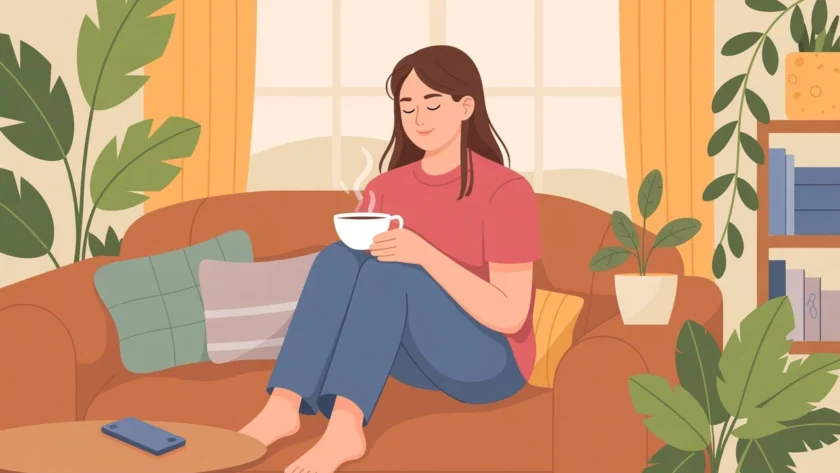I’ll never forget the moment I realized my phone was making my anxiety worse. I was lying in bed at 11 PM, heart racing, scrolling through news headlines and social media updates, telling myself I was “winding down” for the night. But my chest felt tight, my thoughts were spinning, and sleep seemed impossible. Sound familiar?
Here’s what finally got my attention: I noticed that on the rare mornings when I didn’t immediately grab my phone, I felt calmer. My thoughts were clearer. I could actually hear God’s whisper instead of the constant noise of notifications, opinions, and carefully curated lives that made my own feel lacking. That realization started me on a journey of understanding how deeply our screen habits affect our anxiety—and more importantly, how reducing screen time can genuinely bring relief.
If you’ve been struggling with anxiety and find yourself constantly connected to devices, this guide is for you. Let me share what I’ve learned about the connection between our screens and our stress levels, and how we can reclaim peace in this digital age.
The Screen Time-Anxiety Connection: What’s Really Happening
When I first started researching the link between screen time and anxiety, I expected to find some evidence, but I wasn’t prepared for how strong that connection really is. Our brains weren’t designed for the constant stimulation and information overload we experience through our devices.
Think about it this way: every time we check our phones, we’re potentially exposing ourselves to dozens of micro-stressors. A concerning news headline. A friend’s perfect vacation photos when we’re struggling financially. An email that reminds us of unfinished tasks. A text we feel obligated to answer immediately. Each one seems small, but they accumulate like drops filling a bucket—eventually, that bucket overflows into full-blown anxiety.
What I’ve come to understand through my own experience and working with others is that excessive screen time creates a perfect storm for anxious thoughts. The blue light disrupts our sleep patterns, leaving us exhausted and more vulnerable to worry. The constant connectivity keeps our nervous system in a state of alert, never allowing us to truly rest. And perhaps most significantly, endless scrolling robs us of the quiet moments where we might otherwise pray, reflect, or simply be present.
In Scripture, we’re reminded in Psalm 46:10 to “Be still, and know that I am God.” But how can we be still when our phones are buzzing with demands for our attention? How can we know God’s peace when we’re constantly absorbing everyone else’s opinions and anxieties?
Understanding Your Screen Habits: The First Step Toward Change

Before we can reduce screen time for anxiety relief, we need to get honest about our actual usage. I remember when I finally checked my screen time stats—I was spending over five hours a day on my phone, and I had convinced myself it was “maybe an hour or two.” That wake-up call was uncomfortable but necessary.
Here’s what I’ve learned works: spend a week simply observing your screen habits without judgment. Notice when you reach for your phone. What are you feeling in those moments? Bored? Anxious? Lonely? For me, I discovered I was using my phone as an escape whenever uncomfortable emotions surfaced. Instead of sitting with those feelings or bringing them to God in prayer, I was numbing them with distraction.
Pay attention to how you feel after different types of screen time, too. I noticed that twenty minutes of scrolling social media left me feeling drained and anxious, while video chatting with my sister actually helped me feel connected and calm. Not all screen time is created equal, and understanding these distinctions is crucial.
Also, take note of your physical responses. Does your jaw clench when you read certain content? Does your heart rate increase? Do you get that familiar knot in your stomach? These bodily signals are valuable information about what’s feeding your anxiety.
Setting Realistic Boundaries: Creating Your Digital Detox Plan
Now, I’m not going to tell you to throw your phone in a drawer and become a digital hermit. That’s not realistic, and honestly, it’s not necessary. What works is creating intentional boundaries that protect your peace while still allowing you to function in our connected world.
Start with what I call “sacred screen-free times.” For me, these became non-negotiable: the first hour after waking and the last hour before bed. Those morning moments are now for prayer, reading Scripture, and setting my intentions for the day. My evenings are for genuine rest—maybe reading an actual book, talking with my husband, or just sitting on the porch with Bailey, my rescue dog, watching the sunset. These bookend practices have transformed my anxiety levels more than anything else I’ve tried.
Here’s something that might surprise you: I also set boundaries around “anxiety-triggering” content. I unfollowed news accounts that sent me into spirals of worry. I muted people whose posts consistently made me feel inadequate or stressed. I deleted apps that I used compulsively without any real benefit. It felt strange at first—like I was being irresponsible or burying my head in the sand. But what I discovered was that I wasn’t actually staying “informed”—I was just staying anxious.
Consider implementing tech-free zones in your home, too. Our bedroom became a phone-free space, which meant getting an actual alarm clock instead of using my phone. Our dinner table became sacred—no devices allowed. These physical boundaries create mental space for connection and calm.
Alternative Activities: Filling the Space with Life-Giving Practices
Here’s what nobody tells you about reducing screen time: you’ll suddenly have hours of your day back, and you’ll need to fill them with something. Otherwise, you’ll default right back to your phone out of sheer habit or boredom.
What I’ve found most helpful is replacing screen time with activities that actively reduce anxiety rather than just avoiding what increases it. Prayer and meditation top my list. When I would have grabbed my phone for a quick scroll, I now take five minutes to breathe deeply and talk to God. Sometimes it’s formal prayer. Sometimes it’s just sitting quietly and imagining His presence surrounding me like a warm blanket.
Physical movement has been another game-changer. Instead of lying in bed scrolling first thing in the morning, I take Bailey for a walk. The fresh air, the movement, the simple act of noticing creation around me—it sets such a different tone for my day. Even a ten-minute walk makes a difference.
I’ve also rediscovered the joy of reading actual books. There’s something about holding physical pages, not being interrupted by notifications, and letting a story or idea unfold at its own pace. It engages my mind without overstimulating it. I keep a stack of books on my nightstand now—a mix of fiction for enjoyment and books about faith and personal growth.
Creative activities help, too. I started journaling regularly, which gives me a place to process anxious thoughts instead of bottling them up or seeking distraction. Some people find that drawing, painting, gardening, or cooking serve this same purpose—engaging your hands and mind in something productive and calming.
Practical Strategies for Success: Making It Stick
Let me be real with you: changing screen habits is hard. Our phones are designed to be addictive, and breaking that pattern requires intentional strategies and a lot of grace for yourself.
One approach that’s worked for me is using technology to limit technology. I know that sounds ironic, but apps like Freedom or Forest can block distracting apps during certain hours. I also changed all my phone settings to grayscale during evenings, which makes scrolling far less appealing. The colorful, dopamine-triggering design loses its pull when everything looks like an old newspaper.
I also recommend telling people about your boundaries. Let friends and family know you’re not responding to texts immediately anymore, or that you’re not checking social media before noon. This removes the pressure you might feel about being constantly available and sets realistic expectations.
Find an accountability partner if possible. My friend Sarah and I check in weekly about our screen time goals. We’re honest about our struggles and celebrate our wins. Having someone who understands makes the journey less lonely.
And here’s something I had to learn the hard way: plan for slip-ups. You’re going to have days when you fall back into old patterns. Maybe you’re sick and spend the day on the couch watching mindless videos. Maybe a stressful event sends you into a scrolling spiral. That’s okay. God’s mercies are new every morning (Lamentations 3:22-23), and so are your chances to recommit to healthier habits.
The Spiritual Dimension: Finding God in the Quiet
What surprised me most about reducing screen time wasn’t just that my anxiety decreased—it was that my awareness of God’s presence increased. When I stopped filling every quiet moment with digital noise, I created space for the Holy Spirit to speak.
There’s a beautiful verse in 1 Kings 19:11-12 where Elijah is searching for God. God isn’t in the powerful wind or the earthquake or the fire—He’s in the “gentle whisper” that follows. Friends, we can’t hear gentle whispers when we’re constantly scrolling through the noise of the digital world.
I’ve started thinking of my phone as a tool, not a companion. It serves me; I don’t serve it. And the time I’ve reclaimed? That’s become sacred space for deepening my relationship with God. Morning quiet time without the distraction of checking messages first. Evening reflection instead of mindless scrolling. Moments throughout the day where I actually notice beauty, feel gratitude, and remember that I’m held in divine love.
Philippians 4:6-7 tells us, “Do not be anxious about anything, but in every situation, by prayer and petition, with thanksgiving, present your requests to God. And the peace of God, which transcends all understanding, will guard your hearts and your minds in Christ Jesus.” But we have to create the conditions where we can actually experience that peace. We have to choose practices that guard our hearts and minds rather than bombarding them with endless information and stimulation.
Moving Forward: Your Next Steps
If you’re feeling overwhelmed by the idea of a digital detox, start small. Don’t try to overhaul everything at once. Pick one boundary to implement this week. Maybe it’s no phones during meals. Or no social media before 10 AM. Or charging your phone outside your bedroom at night.
Notice how it feels. Pay attention to your anxiety levels. Give yourself permission to adjust as needed. This isn’t about perfection—it’s about progress toward greater peace.
Remember that reducing screen time for anxiety relief isn’t about deprivation. It’s about reclaiming your attention, your time, and your mental space for things that truly matter. It’s about creating room for God’s voice to break through the noise. It’s about nurturing your mental health with the same intentionality you’d bring to any other aspect of wellness.
You don’t have to stay trapped in patterns that feed your anxiety. With God’s help and some practical boundaries, you can experience genuine relief. The peace you’re longing for? It’s not hiding in your phone. It’s waiting in the quiet spaces you create when you set your device down and remember that you are deeply loved, fully known, and held in grace.
Start today. Put your phone down for the next hour. Take a walk. Pray. Breathe. Notice how you feel. That’s the beginning of freedom.



